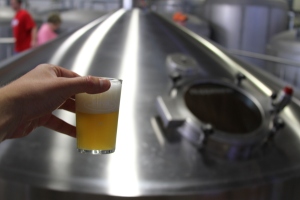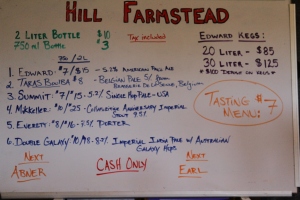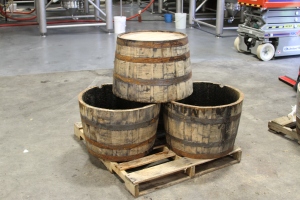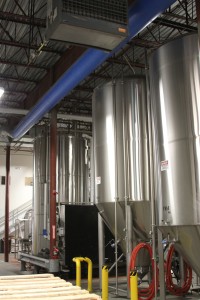Dear Reader,
Over the last few months I’ve entered about 50 posts into the annals of history by scrawling them on the cave wall that is this blog. They have been met with nearly universally mild interest, a smattering of attention, and a fair amount of kind words. The days in which my blog received the most hits were tense for me as I had written about Dogfish Head Brewing in Delaware in what I felt was an honest way. I had been mildly disappointed by my visit, not because of the quality of the beer or the service, but rather because I had built up the experience in my head before arriving and upon arrival it wasn’t everything I had hoped it would be.
I had written more, but decided it would be a disservice to Harpoon Brewing in Boston to include it here – suffice to say that everything at Harpoon reaffirmed my faith in the craft beer industry that had been so long in the building phase. Harpoon is what I want my local craft brewery to be – independent-minded, environmentally-conscious, and goddamn delicious.

This means that, technically speaking, we've arrived.
The tour begins at the entrance to the brewery, with bike racks that bear the Harpoon “H” and doors built to look like bottlecaps guarding the pipework for their outdoor fermenters.

Fermenters and piping, disguised as bottlecaps - quirky and functional.

- Biking and brewing, the match made in heaven!
From there you make your way inside and up the stairway to the taps, store, and tour jumping off point. Each tour ends with 30 minutes of uninterrupted tasting from the taps, so as you arrive you are greeted by the previous tour making their way through the tap list with greedy smiles and minor stumbles. And you’re jealous, trust me. Each session of tasting ends with a ringing bell that lets the drinkers know they’ve got one pour left and they best make it a good one.

Happy folks at the end of the tour - 30 minutes of beer can solve most of the world's ills 🙂
Let me take a moment before I dive into the specifics of the tour and the brewhouse to touch on the atmosphere of Harpoon. Everyone is smiling – patrons, tour guides, guide dogs, everyone – and the feeling of the place is infectious. When you enter the upstairs area between the folks enjoying their free pours and the crowd of people waiting for their turn the excitement of the place is palpable – encouraged, aided, and abetted by the staff who seem to genuinely be having a good time pouring beer and giving tours. It seems like a minor detail until you run into places where the folks aren’t into the beer like you are, and it does harsh the buzz so to speak.

Cheers!
The tour itself starts on the brewing platform, with 140-barrel containers surrounding you as you sip on your first taste of the tour – in this case a bit of UFO Raspberry held in front of the immense boil kettle. The Raspberry and Hefeweizen are both delicious, as are the White and Pale UFO offerings. The UFO series are among my favorite discoveries of the trip, each unfiltered and showing what lacking filtration does to a slightly different beer style. While Whites are typically unfiltered as are Hefs, the Raspberry and Pale are fun twists on the same theme, and both work well. After a bit of time spent up top, the crowd descends toward the packaging area and storage of the brewery.

Their motto is all about priorities - first things first.
This is where something magical happened. Literally the most unexpected occurrence of our trip. Something that would’ve made the folks worried about insurance concerns cry themselves to sleep. Out tour guide did the following things, in exactly this order. He took a spray bottle of sanitizer, and quickly doused a spigot fed from the fermenter halfway down the row. He then had a torch handed to him, and blasted the spigot to rid it of any lingering doubts of contamination. Then, green IPA was poured into a pitcher and passed around the group so everyone could taste a green beer and get an idea of the brewing process.

He's pointing out that it's not in actuality green - I was astonished.
To those of you reading at home who aren’t brewers – go here, do this, drink green beer, because holy hell does it give you a great idea of what pours into your glass and where it comes from.

Beer + Pitcher = Smiles all around
While this may give some lawyers at home nightmares, for me it was a dream come true. I’ve had everything in the homebrewing process from wort, to uncarbonated beer, to shitty swill that I would pour down the drain sober, and yet this was on a completely different level. This was commercial beer, unfinished, and offered to the public as part of an ingenious outreach program – the first beer poured on your return is the finished IPA, maybe ten minutes after the green beer and of course soon enough to give an understanding of the changes happening in those big metal conicals.

What I can only assume is a pallet of UFO Hef for staff, which of course makes me jealous.
After a quick tour of the bottling line, a gorgeous view of the packaging area that made me weak in the knees (see below) and a few stories about the company and brewery we all headed back to the brewing platform and into the tasting room.

The building was built to withstand WWII era blasts, and now it makes beer - change for the better!
We made our way through the tap list available in the tasting room – a quick rundown here if you’re making your way out that is hopefully helpful. The Cider is a nice jumping off point, light and crisp with no major notes to put you off. The IPA is solid, hoppy, and tasty – and considerably earthy compared to the grapefruit laden West Coast IPAs I’m used to, while the Belgian IPA hits some strong Belgian notes but does miss a bit with the hops I thought. The BIPA could be a great beer, but it doesn’t quite hit all the notes our Belgian loving co-pilot was expecting.
The Anniversary Ale, Rich & Dan’s Rye IPA, was quite good with a solid spicy rye note immediately followed by what initially tastes like sweet hop and finishes dry and bitter. The Leviathan series tugged at my heart-strings, with an Imperial Rye that matches spicy and bitter up in a deathmatch in which only I can be the winner, and an Imperial IPA that hides a 10% ABV surprisingly well under notes of tart, bitter, and citrus. My personal favorite was the Munich Dark ale, a malty brew that was nicely balanced with a mild bitter finish. A tasty dunkel aimed almost specifically at me, the beer reminded me of sitting in my local corner bar in San Francisco sipping a Kostritzer and answering trivia questions poorly.
If you want to experience craft beer, you’re excited for the idea of good beer making its way into your routine, and you’re in the Northeast – Harpoon is waiting for you – what are you waiting for?












































